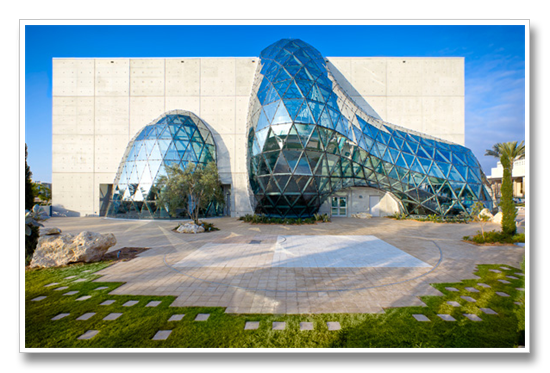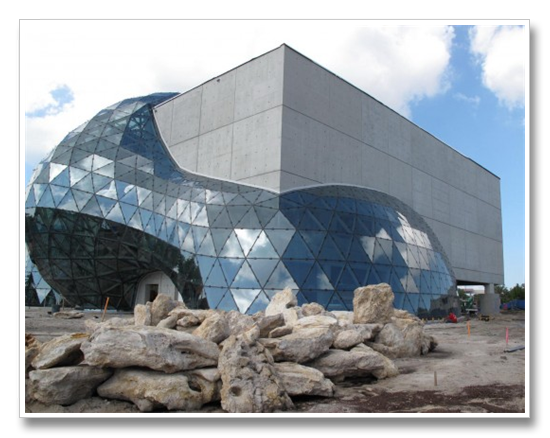“ Each morning when I awake, I experience again a supreme pleasure – that of being Salvador Dali.” Salvador Dali

On a date that would have been perfect for the famous artist Salvador Dali, a museum holding his name and works opens in St. Petersburg, Florida. HOK, along with Beck Group, has designed a new museum with an architecture greatly inspired by the great surrealist, “combines elements of the classical and the fantastical,” according to the director of the museum. The design speaks to the essence of Dalí while incorporating functional elements to combat Florida’s tough weather.

The new $36 million, 66,450-square-foot museum Dali Museum houses more of the artist’s works than any other museum outside Spain, including a permanent collection of 96 oil paintings (including the 8 masterworks), 125 drawings and watercolors, 2,500 prints and photographs, 250 objets d’art, and a 5,000 book library.
While the concrete protects the art, this “treasure box” is broken and disrupted by the organic, triangulated glass “Enigma.” The glass is seen as “contrast between the rational world of the conscious and the more intuitive, surprising natural world” – a recurring theme of Dalí’s work.


The eye-catching spiral staircase references Dali’s fascination with DNA, the golden rectangle and the Fibonacci series. The amazing curve is a “structural tour-de-force, with the reinforced concrete spiral functioning as a tensioned spring held at ground level and at the third floor, with the stair treads cantilevered from the central spiral.”

"Salvador Dali was a monumental pioneer of twentieth-century art and this is perhaps the best collection of his work in the world," said Weymouth. "Our challenge was to discover how to resolve the technical requirements of the museum and site in a way that expresses the dynamism of the great art movement that he led. It is important that the building speak to the surreal without being trite."
Several sustainable design strategies create energy, water and cost savings. The building is sited to reduce solar load from the low-angled western sun. Two types of solar collectors on the roof heat water for the restrooms and assist in the dehumidification cycle of the air conditioning system. Automated controls turn lights off automatically when rooms are not in use. Water is conserved with low-flow fixtures and all water condensate is recycled back into the system. The building envelope is compact, well-insulated and, with its concrete thermal mass, acts as a heat sink to reduce the temperature highs and lows of a typical day.

Salvador Felipe Jacinto Dali I Domenech
Salvador Felipe Jacinto Dali I Domenech was born on May 11, 1904 in the small agricultural town of Figueres, Spain. The son of a prosperous notary, Dali spent his boyhood in Figueres and at the family’s summer home in the coastal fishing village of Cadaques where his parents built his first studio. As an adult, he made his home with his wife Gala in nearby Port Lligat. Many of his paintings reflect his love of this area of Spain.
The young Dali attended the San Fernando Academy of Fine Arts in Madrid. Early recognition of Dali’s talent came with his first one-man show in Barcelona in 1925. He became internationally known when three of his paintings, including The Basket of Bread (now in the Museum’s collection), were shown in the third annual Carnegie International Exhibition in Pittsburgh in 1928.
Dali soon became a leader of the Surrealist Movement. His painting, The Persistence of Memory, with the soft or melting watches is still one of the best-known surrealist works. But as the war approached, the apolitical Dali clashed with the Surrealists and was "expelled" from the surrealist group during a "trial" in 1934. He did however, exhibit works in international surrealist exhibitions throughout the decade but by 1940, Dali was moving into a new type of painting with a preoccupation with science and religion.

Dali and Gala escaped from Europe during World War II, spending 1940-48 in the United States. These were very important years for the artist. The Museum of Modern Art in New York gave Dali his first major retrospective exhibit in 1941. This was followed in 1942 by the publication of Dali’s autobiography, The Secret Life of Salvador Dali.
As an artist, Salvador Dali was not limited to a particular style or media. The body of his work, from early impressionist paintings through his transitional surrealist works, and into his classical period, reveals a constantly growing and evolving artist. Dali worked in all media, leaving behind a wealth of oils, watercolors, drawings, graphics, and sculptures, films, photographs, performance pieces, jewels and objects of all descriptions. As important, he left for posterity the permission to explore all aspects of one’s own life and to give them artistic expression.
Whether working from pure inspiration or on a commissioned illustration, Dali’s matchless insight and symbolic complexity are apparent. Above all, Dali was a superb draftsman. His excellence as a creative artist will always set a standard for the art of the twentieth century.


Greaaat find! I’m sending this to my family in Miami..hoping they will take a drive up to St. Petersburg..
Greaaat find! I’m sending this to my family in Miami..hoping they will take a drive up to St. Petersburg..